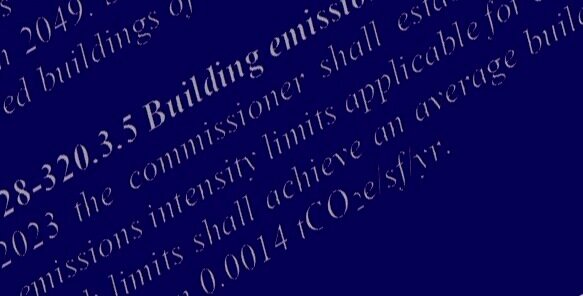Why Target 0.0014 tCO2e/sf-yr for 2050?
One thing New Yorkers generations from now might be grateful for was the passing of Local Law 97 this year to fight Climate Change. If you’ve ever read through the bill, you may wonder why
sections 28-320.3.4 and 3.5 require average emissions for covered buildings up through 2050 not exceed 0.0014 metric tonnes CO2 equivalent per square foot per year. Most of the law is a
black box when it comes to transparent reasoning. For the sake ofte law’s efficacy, this needs to change quickly.
This average building emissions intensity (BEI) of 0.0014 is the compass point. Since no one would provide a derivation, here’s a back-of-the-envelope calculation to encourage a
transparent, rigorous process going forward. See if you can improve upon it:
Average NYC BEI 2050 target (must) = 20% of NYC Building Emissions in 2005
Total NYC Building Area
= (.20)(.73)(61.06x10^6 metric tonnes / yr)
5.75x10^9 sf
= 0.00155 tCO2e/sf-yr
Where:
Citywide Emissions target, 2050 = 20% of NYC citywide 2005 baseline (a)
NYC Buildings contribution = 73% of citywide emissions (b)
Citywide Emissions, 2005 baseline = 61.06 million metric tonnes CO2e/yr (c)
Then if we account for projected population growth from 2005 to 2050 and assume built area remains proportional to population:
Average NYC BEI 2050 target = 0.00155 tCO2e/sf-yr (8.14x10^6 New Yorkers in 2005 / 9.2x10^6 New Yorkers in 2050)
= 0.00137 tCO2e/sf-yr (QED)
Where:
8.14 million NYC 2005 pop.d and 9.2 million projected for 2050.(e)
Based on this simple calc’, 0.0014 appears credible. But think a moment: it doesn’t include any accounting for embodied emissions – including limits for those from making the components
for the new retrofits and buildings. It also doesn’t appear to include a margin of safety to manage risk from now through 2050. There will be unforeseen setbacks, and course correction will
become decreasingly feasible the nearer to 2050.(f)
While 0.0014 is a rational start to stabilizing NYC’s operational building emissions, an engineered, open peer review approach is required.
NOTES
a. 80% emissions reduction by 2050 has been adopted by a number of cities and states for its claimed likelihood of limiting average global warming to 2C and mitigating long term, irreversible
damage. 80% is required, regardless of time frame to level off greenhouse gas concentrations (ppmv; Solomon et al. (2010). Climate Stabilization Targets: Emissions, Concentrations, and
Impacts Over Decades to Millennia. Washington, D.C: National Academies Press.)
Fig. 1 Global GHG emissions rate (top graph) must be reduced approximately 80% to level off GHG concentrations (bottom graph).
(Image credit: Solomon et al., 2010)
b. NYC building emissions comprising 73% of citywide emissions based on: One City Built To Last Technical Working Group Report: Transforming New York City Buildings for a Low-Carbon
Future. (2016). 2nd Ed. Mayor’s Office of Sustainability. p.1.
Fig.2 Building contribution of 73% to citywide GHG emissions.
(Image credit: One City Built to Last. Mayor’s Office of Sustainability.)
c. While 61.06 does not yield the most stringent 2050 target, it appears to be the most recently published value for 2005 citywide emissions per: Inventory of New York City Greenhouse Gas
Emissions 2016. Dec., 2017, p.10. Values for 2005 emissions vary between reports, with 55.61 the lowest found (Inventory of New York City Greenhouse Gas Emissions 2014. Published Dec.,
2016. p.41, Table A7). If 55.61 replaces 61.06, the 2050 target is 0.00125 (more stringent).
d. NYC 2005 pop. based on: NYS Department of Health. Vital Statistics. Table 2: Population, Land Area and Population Density by County
. <https://www.health.ny.gov/statistics/vital_statistics/2005/table02.htm>
e. NYC 2050 projected pop. based on: New York City’s Roadmap to 80 x 50. p.55.
f. Consider two distinct risks, both related. One is the risk of NYC not reducing its GHG load on the atmosphere by 80% by the 2050 deadline. The other is the risk associated with the
atmosphere’s response to an 80% reduction, assuming the global community also reduces (80% is not guaranteed to limit warming to 2C). The former is directly within NYC’s power to
influence, the latter not. The uncertainty of NYC meeting its deadline can be analyzed and managed with schedule and cost contingencies and other safety factors. If a margin of safety is
claimed by the choosing of 80%, or in some other manner, that needs to be documented so that overall risk can be agreed on and planned for.
Given it is unethical and illegal to design a single building without safety factors, why would the same standard of care not apply to the fate of a city or state, or the ecosystems
they are duty-bound to protect?



